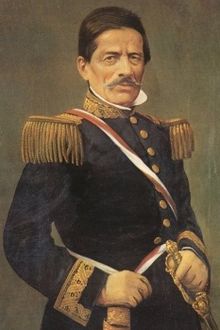Ramon Castilla
| Ramón Castilla y Marquesado | |
|---|---|
 |
|
| 26th President of Peru | |
|
In office February 17, 1844 – August 10, 1844 |
|
| Preceded by | Domingo Nieto |
| Succeeded by | Domingo Elías |
| 31st President of Peru | |
|
In office April 20, 1845 – April 20, 1851 |
|
| Preceded by | Manuel Menéndez |
| Succeeded by | José Rufino Echenique |
| 34th President of Peru | |
|
In office January 5, 1855 – October 24, 1862 |
|
| Preceded by | José Rufino Echenique |
| Succeeded by | Miguel de San Román |
| 36th President of Peru | |
|
In office April 3, 1863 – April 9, 1863 |
|
| Preceded by | Miguel de San Román |
| Succeeded by | Pedro Diez Canseco |
| Personal details | |
| Born |
August 31, 1797 Tarapacá, Viceroyalty of Peru |
| Died | May 30, 1867 (aged 69) Tarapacá, Peru |
| Nationality | Peruvian |
| Spouse(s) | Francisca Diez Canseco |
| Profession | Soldier (Field marshal) |
Ramón Castilla y Marquesado (31 August 1797 – 25 May 1867) was a Peruvian caudillo and President of Peru four times. His earliest prominent appearance in Peruvian history began with his participation in a commanding role of the army of the Libertadores that helped Peru become an independent nation. Later, he led the country when the economy boomed due to the exploitation of guano deposits. Castilla's governments are remembered for having abolished slavery and modernized the state.
He assumed the presidency for the first time after general Domingo Nieto's death for a short period in 1844, then in 1845 until 1851, again from 1855 to 1862 and, finally, during a brief period in 1863.
Castilla was born in Tarapacá (then part of the Viceroyalty of Peru), the second son of Pedro Castilla, of Spanish-Argentine origin, and Juana Marquezado de Romero, who was of part Aymara descent. In 1807 he traveled to Lima at the age of 10 to study with his brother and later continued his education in Concepción, Chile, also helping his brother with his business. In 1817 he enrolled in the Spanish colonial army during Peru's War of Independence, fighting against the independence forces sent by Argentine general José de San Martín.
Castilla became a prisoner of war, but managed to escape and returned to Peru in 1821, deserting the Spanish Army and offering his services to José de San Martín, who enrolled him in the Patriot Army with the rank of lieutenant (a rank he had held with the Spanish Army). When San Martin resigned as "Protector of Peru", Castilla sided with José de la Riva Agüero, who in turn shortly became president in 1823.
...
Wikipedia
